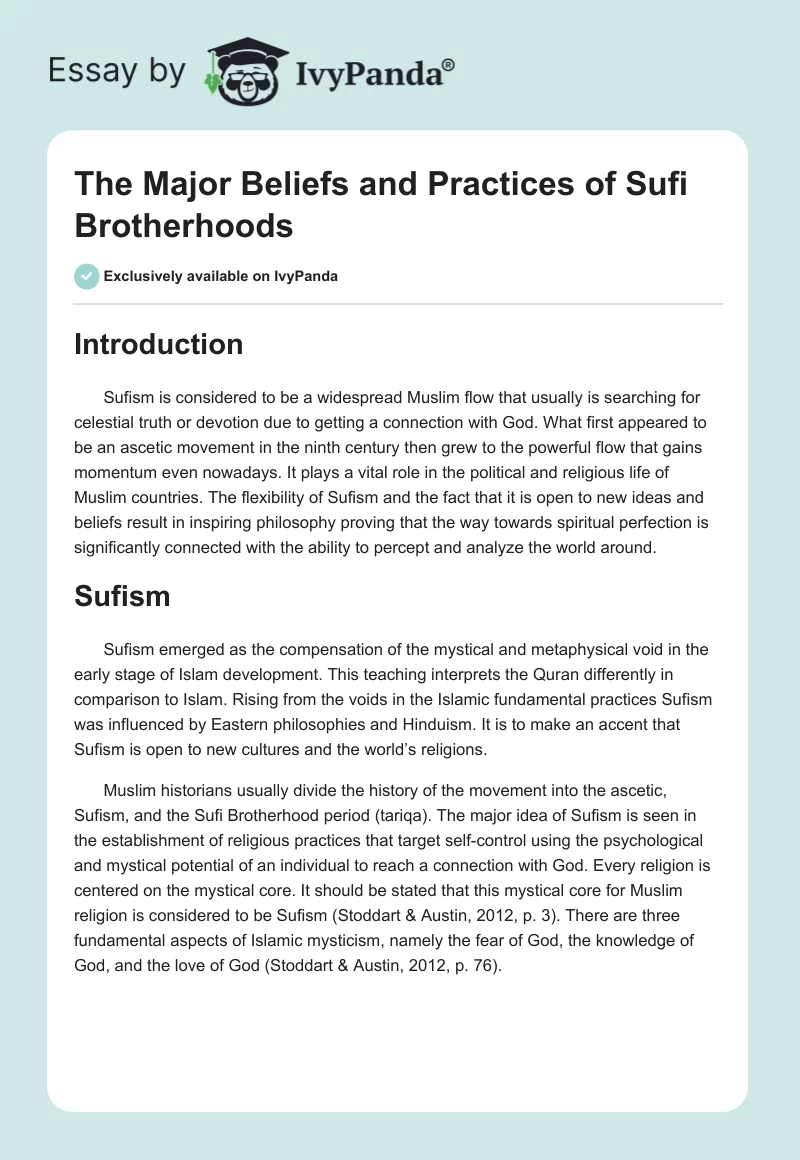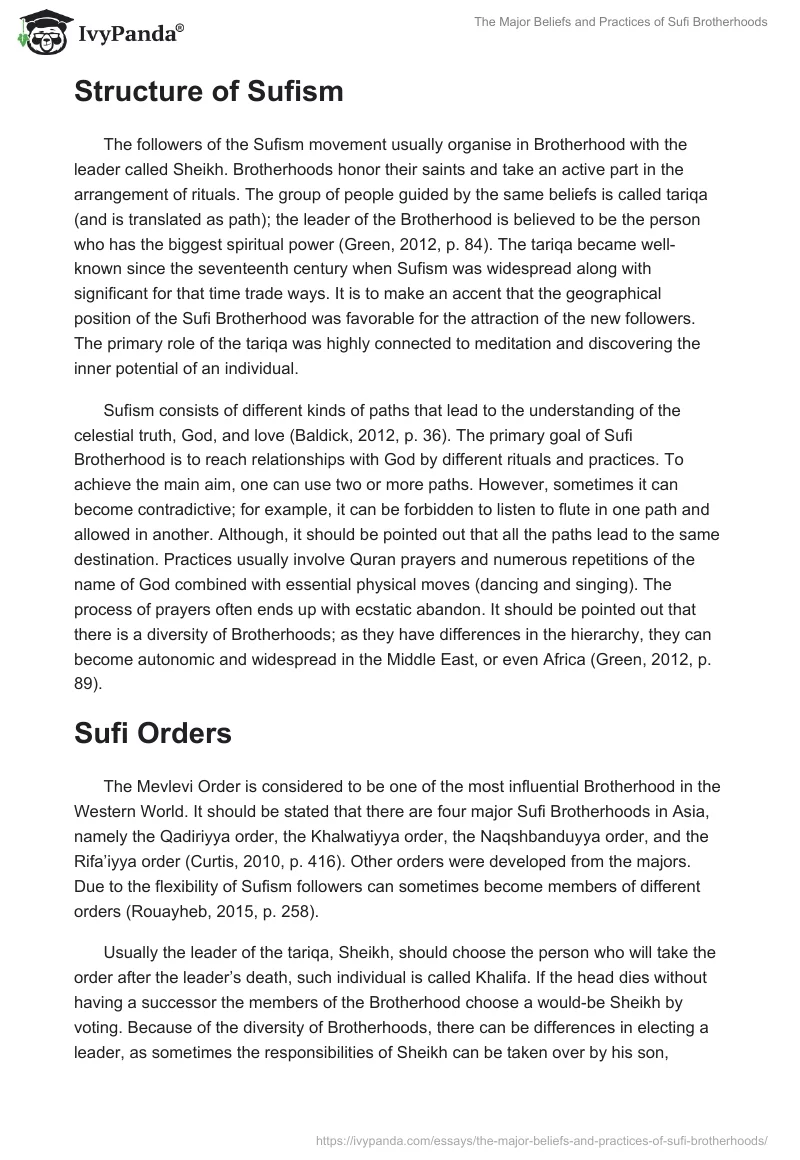Introduction
Sufism is considered to be a widespread Muslim flow that usually is searching for celestial truth or devotion due to getting a connection with God. What first appeared to be an ascetic movement in the ninth century then grew to the powerful flow that gains momentum even nowadays. It plays a vital role in the political and religious life of Muslim countries. The flexibility of Sufism and the fact that it is open to new ideas and beliefs result in inspiring philosophy proving that the way towards spiritual perfection is significantly connected with the ability to percept and analyze the world around.
Sufism
Sufism emerged as the compensation of the mystical and metaphysical void in the early stage of Islam development. This teaching interprets the Quran differently in comparison to Islam. Rising from the voids in the Islamic fundamental practices Sufism was influenced by Eastern philosophies and Hinduism. It is to make an accent that Sufism is open to new cultures and the world’s religions.
Muslim historians usually divide the history of the movement into the ascetic, Sufism, and the Sufi Brotherhood period (tariqa). The major idea of Sufism is seen in the establishment of religious practices that target self-control using the psychological and mystical potential of an individual to reach a connection with God. Every religion is centered on the mystical core. It should be stated that this mystical core for Muslim religion is considered to be Sufism (Stoddart & Austin, 2012, p. 3). There are three fundamental aspects of Islamic mysticism, namely the fear of God, the knowledge of God, and the love of God (Stoddart & Austin, 2012, p. 76).
Structure of Sufism
The followers of the Sufism movement usually organise in Brotherhood with the leader called Sheikh. Brotherhoods honor their saints and take an active part in the arrangement of rituals. The group of people guided by the same beliefs is called tariqa (and is translated as path); the leader of the Brotherhood is believed to be the person who has the biggest spiritual power (Green, 2012, p. 84). The tariqa became well-known since the seventeenth century when Sufism was widespread along with significant for that time trade ways. It is to make an accent that the geographical position of the Sufi Brotherhood was favorable for the attraction of the new followers. The primary role of the tariqa was highly connected to meditation and discovering the inner potential of an individual.
Sufism consists of different kinds of paths that lead to the understanding of the celestial truth, God, and love (Baldick, 2012, p. 36). The primary goal of Sufi Brotherhood is to reach relationships with God by different rituals and practices. To achieve the main aim, one can use two or more paths. However, sometimes it can become contradictive; for example, it can be forbidden to listen to flute in one path and allowed in another. Although, it should be pointed out that all the paths lead to the same destination. Practices usually involve Quran prayers and numerous repetitions of the name of God combined with essential physical moves (dancing and singing). The process of prayers often ends up with ecstatic abandon. It should be pointed out that there is a diversity of Brotherhoods; as they have differences in the hierarchy, they can become autonomic and widespread in the Middle East, or even Africa (Green, 2012, p. 89).
Sufi Orders
The Mevlevi Order is considered to be one of the most influential Brotherhood in the Western World. It should be stated that there are four major Sufi Brotherhoods in Asia, namely the Qadiriyya order, the Khalwatiyya order, the Naqshbanduyya order, and the Rifa’iyya order (Curtis, 2010, p. 416). Other orders were developed from the majors. Due to the flexibility of Sufism followers can sometimes become members of different orders (Rouayheb, 2015, p. 258).
Usually the leader of the tariqa, Sheikh, should choose the person who will take the order after the leader’s death, such individual is called Khalifa. If the head dies without having a successor the members of the Brotherhood choose a would-be Sheikh by voting. Because of the diversity of Brotherhoods, there can be differences in electing a leader, as sometimes the responsibilities of Sheikh can be taken over by his son, although, it is prohibited to have the relationship between Sheikh and successor in some groups (Curtis, 2010, p. 409).
The Qadiriyya Order
The Qadiriyya order is considered to be one of the most popular across the globe (Biegman, 2009, p. 19). In every Muslim country, the members of the Qadiriyya can be found. It was founded by one of the most famous Sheikh in Sufism called Abdul Kadir al-Jilani who sometimes referred as Geylani. The specific features differ within the order as it is considered to be typical for Brotherhoods. There are certain rules that the leader of the tariqa should follow, namely not to lie, to make promises and fulfill them, and never to be jealous (Biegman, 2009, p. 20). The followers of the order define Sufism as the moral-ethical teaching and eliminate ecstatic and theosophical- speculative elements. Asceticism is strongly prohibited according to the beliefs of the order. The members of the order advocate the ‘sober’ form of mysticism.
The Khalwatiyya Order
The Khalwatiyya order was established by Umar al-Khalwati. This Brotherhood is very widespread across the Balkans. The Khalwatiyya is considered to be less unusual among all the branches of Sufism. The fundamental features of this Brotherhood are believed to be silence, hunger, and seclusion (Biegman, 2009, p. 20). Their discipline, meditations, and rituals are very similar to Islamic orthodoxy (Biegman, 2009, p. 20). The theoretical teaching of the order is centered on the individualism and is in favor for asceticism.
The Naqshbanduyya Order
The Naqshbanduyya order was founded by Baha al-Din Nakshband in Turkestan and is widespread in India and Turkey. Their respectful attitude towards Shari’a helped the Brotherhood to become acceptable and relevant for religious scholars (Biegman, 2009, p. 21). The distinguishing feature of the order is that the origin of the Brotherhood is considered to be significantly connected to the Prophet Muhammad, whereas the other orders are linked to the Ali ibn Abu-Talib (Biegman, 2009, p. 65). There are eleven major principles that the members of the order should follow. The most significant is to feel a close connection with God and appreciate time as the biggest value that needs to be used in an appropriate way.
The Rifa’iyya order
It should be stated that Rifa’iyya order is enjoying the popularity across Balkans and is one of the most widespread orders in the whole world. It is very influential Brotherhood in Egypt, Turkey, and Syria. Rifa’iyya order was founded by Ahmad Al-Rifa’i (Biegman, 2009, p. 21). The order became famous due to the practice of expulsion of evil spirits. The followers of the order struggle with the human failings by praying; they keep to lent and view seclusion as one of the best ways to achieve the understanding of God.
The Importance of the Brotherhoods in the Modern World
Sufism is significantly important in the world where people are possessed of money and are too busy to develop their spiritual potential. According to the four major orders every individual who is not religious and does not follow the principles of the Muslim mysticism cannot see beyond the darkness. The only chance to discover the truth is to worship God imagining that one can see him standing by (Rabia & Arsheed, 2013, p. 3). The primary obstacle in the way of discovering the truth is that the path (tariqa) is difficult to be found unless the teacher who will show the way out of obscurity.
Rumi, the famous Islamic scholar and the follower of Sufism, once stated that “God turns you from one feeling to another and teaches by means of opposites, so that you will have two wings to fly not one” (Nelson, 2011, p. 111). The fundamental approach of the orders is to reach happiness making the mind clear from all the anger and fear that the humanity gained for centuries. Sufism can be considered not only as the powerful form of Islamic mysticism but as the rules that people should keep to in order to have a life full of happiness and love. Modern people should take into account that everyone should be treated respectfully; one should never hurt anyone with the words as it will be impossible to reach God spreading chaos and anger.
Despite the fact that Sufism is a flexible philosophy with a moral covenant in the core of it, it is affected by another current Islamic movement Wahhabism, which aims to get rid of all the practices and ideologies that emerged after Muhammad’s time. However, Sufism attracts a lot of scholars and people who are looking for the development of their spiritual potential. The orders in the modern world can be seen as the possibility of changing the stereotype about Islam and finding similarities between the Eastern and Western world. Finding common sense between cultures is especially important during the globalization process.
Conclusion
In conclusion, it should be stated that the powerful movement Sufism gains momentum nowadays. It should be pointed out that the differences between the orders can be viewed as the diversity of paths that can be chosen to achieve the primary goal the Sufi ideology. Experiencing the influences from different religious systems, beliefs, and philosophy doctrines Sufism is considered to be open to the outside impact. The primary aim of the Sufi teaching is to reach God, and the only way to accomplish the goal is to find the God inside; this can be done by exploring mystical paths, praying, and fulfilling of all the rules that the Sufi followers should keep to. The flexibility of Sufism allows the members of the orders to direct their potential towards the understanding of the celestial truth that is significantly relevant for modern times.
References
Baldick, J. (2012). Mystical Islam: An introduction to Sufism. New York, NY: New York University Press.
Biegman, N. (2009). Living Sufism: Rituals in the Middle East and the Balkans. New York, NY: American University in Cairo Press.
Curtis, E. (2010). Encyclopedia of Muslim-American history. New York, NY: Infobase Publishing.
Green, N. (2012). Sufism: A global history. Malden, MA: John Wiley & Sons.
Nelson, C. (2011). Rising from ashes: Discover your hidden power through adversity. New York, NY: Morgan James Publishing.
Rabia, N., & Arsheed, M. (2013). Role and importance of sufism in the modern world. International Journal of Advancements in Research & Technology,2(1), 1-9.
Rouayheb, K. (2015). Islamic intellectual history in the seventeenth century: Scholarly currents in the Ottoman Empire and the Maghreb. Cambridge, U. K.: Cambridge University Press.
Stoddart, W., & Austin, R. (2012). Outline of Sufism: The essentials of Islamic spirituality. Bloomington, Ind: World Wisdom.


